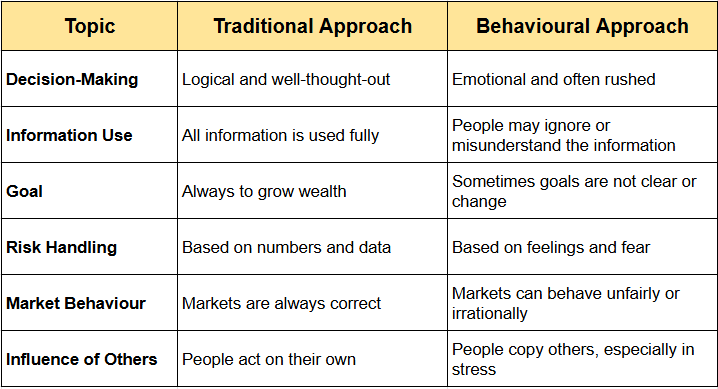
Have you ever made an investment decision driven by emotions, like the fear of losing more money, panic after market news, or simply following advice from someone you trust?
People generally assume that they make financial decisions solely based on logic. This is the traditional school of thought where it is assumed that people or investors take rational investment decisions without considering their emotions or personal biases.
But in reality, a lot of investors tend to behave emotionally and make financial decisions accordingly, which can prove to be detrimental in the future.
In a behavioural approach, people make financial choices through recognition of human imperfections in logical thinking. The fundamental difference between the behavioural approach and the traditional approach is that the behavioural approach acknowledges that people often make decisions that deviate from rationality.
Here’s what it is generally:
Example of some common behavioural approaches
The traditional approach is based on the belief that people always make logical choices with their money. It assumes that:
Here is a simple comparison of the two ways of approaches:

We will examine specific real-world scenarios which demonstrate the differences between these two approaches.
Traditional View: A person will buy more quality stocks to invest at a lower cost.
Behavioural View: A person will be scared and stop their SIP or sell quality stocks.
Traditional View: The person will look at long-term goals and plan accordingly.
Behavioural View: The person may get overconfident and take more risk than needed, or might redeem them early.
Traditional View: The person will choose the one with better long-term returns after proper comparison. They would also consider their risk-taking capacity before making the investment.
Behavioural View: The person will choose the fund which gave better returns in the past, assuming that it will also generate good returns in future. Also, ignoring the risk and uncertainty in the market while investing.
Traditional and behavioural approaches offer two different ways to understand money decisions. The traditional approach believes people are logical and always act to increase their wealth in the best way. The behavioural approach says people are human, they make errors, feel emotions, and sometimes act without thinking clearly. Neither is completely right nor wrong. Real life is a mix of both. To manage money wisely, it’s essential to understand not only the numbers but also how the mind works.